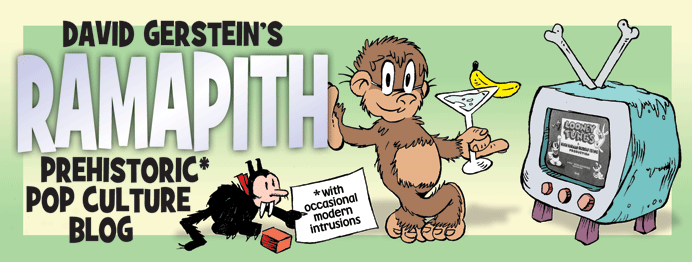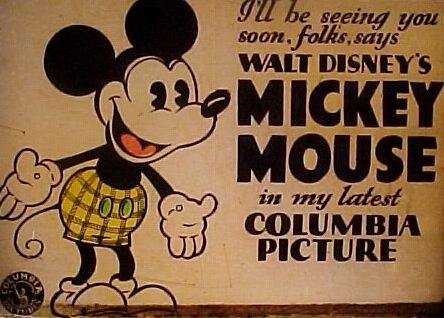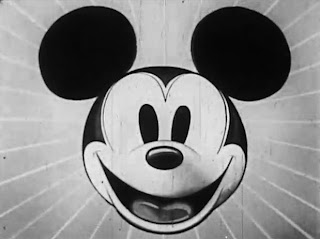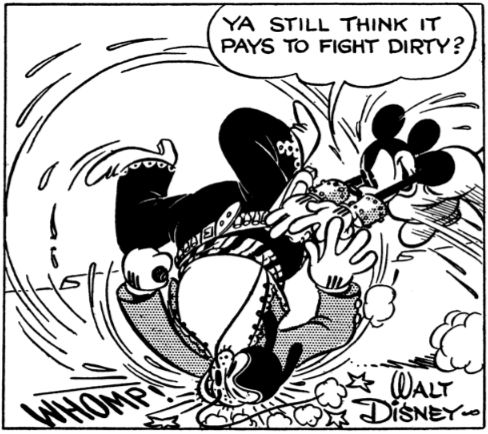And look for.
Just for instance—I've been looking for lost scenes. Thanks to the help of Tom Stathes, Mark Kausler, and others, I'm pleased to present here a rare Columbia Krazy Kat cartoon—The Katnips of 1940 (1934)—without original titles (sorry!) but with two musical numbers we don't usually see.
The Busby Berkeley-like "Dance of the Girl With the Fan" seems to have made it past the Hays Code, but was dropped from the commonly seen TV print. So was "What a New Deal," celebrating (what else?) the New Deal and the end of Prohibition.
Moving on, let's see—I've been looking for lost films. The Romer Grey animation studio is almost unknown today; set up in 1930 by the son of Wild West novelist Zane Grey, it started work on four cartoons featuring the Mickeylike character Binko the Bear Cub. While Binko himself was a cheerful nonentity, Grey provided early employment for more than a dozen famous animators, including Bob McKimson, Tom McKimson, Preston Blair, Pete Burness, Jack Zander, Cal Dalton, and Riley Thomson. Many of these talents' very first animation was on Binko cartoons.
The four films that went into production—Arabian Nightmare, Hot-Toe Mollie, Binko the Toreador and Sand Witches (all 1930-31)—are often described as never completed; Michael Mallory has referred to the first two as "ready to be duped."
I'm pleased to report that somehow, Hot-Toe Mollie made it past that stage; and not long ago I located a mostly complete print in a private collection. I don't have good quality footage yet, but here's your first glimpse of this long-lost Binko adventure:








(From one obscure studio to another: animation of the galloping donkey [image 2] was reused in Boyd La Vero's Mexicali Lilly [1932], a Marty Monk cartoon. What was the connection? Animator Cal Dalton worked for both Grey and La Vero.)
Those of you near Michigan might get to see Hot-Toe Mollie in an hour! As of a last-minute decision, my friend and colleague Steve Stanchfield will be premiering our newly recovered element in "Out of the Inkwell, Out of the Vaults": a screening this afternoon at the Detroit Film Theatre. Mollie will be shown in the last third of the screening (likely around 3:45 PM), so if you're nearby, drop in! I promised to put up this post as a kind of program note.
If you can't make it to Detroit immediately, don't worry—Mollie will appear before too long on an exciting DVD project. Keep your white-gloved fingers crossed.
(Update Dec 1: Steve's Detroit show went over nicely. Thanks for coming, all.)
Now where was I? Oh, yeah—I've been looking for lost facts. Hey, maybe it's time for another installment of that infamous Ramapith "subseries"... Legendbreakers!

Legend: In 1938, infamous Popeye nemesis Bluto lost his voice—literally!—due to the death of Fleischer voice artist Gus Wickie. We're not sure how Wickie died... but as of 1938, he was gone, gone, gone. Blow me down!
Status: FALSE.
Examples:
[Leslie Cabarga, The Fleischer Story, 1988]
"Gus Wickie [was] the baritone member of a vocal quartette used by Paramount. It is Wickie's deep voice and heartily wicked laugh that is most familiar to fans of the Fleischer Popeye cartoons. When Wickie died several others filled in..."
[Tim Lawson, The Magic Behind the Voices, 2004]
"[When] former vaudeville singer Gus Wickie... passed away, others tried their hand at the [Bluto] role..."
[Wikipedia, as of 30 Nov 2013]
"[Wickie] was the voice of Bluto in the Fleischer Studios Popeye cartoons from 1935 until his death in 1938."
Origins: The story of Wickie dying in 1938... where did it get started? I'm away from my older notes and resources at the moment, and will update this blogpost later. But for now, let's presume the concept originated in Fleischer staffers' later memories—which, it seems, weren't quite right. A January 8, 1947 Variety obituary (!) corrects the record. And, like many other documents, it corrects a certain surname...
 |
| Gus Wicke's 1917 draft card. Image courtesy Don M. Yowp |
(Update 11/30/13: Thanks to fellow cartoon researcher Don M. Yowp for Wicke's draft registration card, which included the discoveries of his missing eye and exact birthdate. I previously had only "abt 1886," from a 1940 census. Great finds, Don.)
The young adult Gus was an entertainer from the start. As early as September 9, 1916 (in a story dated 9/2/16), Billboard cites Wicke as a cast member in The Big Show, a Charles Dillingham production at the Hippodrome theatre. Then on February 6, 1926 (in a story dated 1/30/26), Billboard notes the debut of "The Westerners, a five-people harmony, singing and comedy offering with Gus Wicke, late of the Texas Four, which act recently broke up..."
In 1929, Billboard (7/13), the Boston Globe (9/8) and other papers noted Wicke "among the principals" in R. H. Burnside's "mammoth" production Here and There. In 1931, Billboard (1/3) finds Wicke in the Hammerstein musical comedy Ballyhoo—playing a "Mr. Pidgeon," though we don't learn whether the character was a bearded sailor.
Mid-1930s texts again reference Wicke's role in a quartet. Billboard 7/22/36: "...Jerry White, Gus Wicke, Fred Bishop and Paul Davin, the Gay Nineties quartet, have been renewed at that New York night spot by Bill Hardy..."
These same texts confirm that Wicke and the legendary "Wickie" are one and the same. On February 5, 1938, The New York Post described the opening of the Radio Franks Club, "marking the reunion of the radio harmony team of Frank Bessinger and Jerry White, hosts... [performers include] the 'Mauve Decade' Quartet, featuring Gus 'Popeye' Wicke and Fred Bishop."
On February 13, the New York Times refers to the Franks Club and "Gus Wickie [sic], the swell bass"... and, apparently, the origin of the misspelling.
The Brooklyn Eagle's "Manhattan Night Spots" column on January 20, 1939 covers the Radio Franks once more—again mentioning "Gus (Popeye) Wicke, comic." It seems Wicke was known more for being a Popeye cast member than for voicing Bluto specifically. Or maybe Wicke, in 1939, simply rode the presumption that he actually voiced Popeye?
Wait a minute—1939! Yes... after 1938, it is clear now that Wicke simply went on living. "This New York," in the Charleston Daily Mail for June 20, once again references "Gus Wicke, whose foghorn voice makes bullfrogs turn greener with envy."
The New York Herald Tribune on February 21, 1940 states that "...Bill Hardy will fete Spike Harrison, Gus Wicke and Fred Bishop tonight in honor of their five years of service." Billboard's 1/10/42 nightclub reviews cite Wicke again and name Hardy's club: Bill's Gay Nineties.
A portrait begins to emerge: Gus Wicke was a highly popular entertainer, featured at Bill's Gay Nineties—but also at the Radio Franks and elsewhere. His quartet teammates included Bishop, Harrison, and a rotating fourth member.
His popularity seems to have been such that he didn't need animation. The Fleischer studio moved to Florida; "Bluto" stayed behind in Nassau, New York—though, like his cartoon counterpart, he did his villainous bit for the war effort. Billboard's February 19, 1944 "American Theatre Wing" lists Wicke among those who entertained the troops.
What didn't Gus Wicke do? He didn't sail on the SS Dresden from Bremen to Detroit in 1893, nor was he a 17-year-old farmer at the time; that was an unrelated August Wicke. He didn't live for decades in Albany, New York with a wife named Caroline (in 1920) and a wife named Elizabeth (in 1935). That was another unrelated August Wicke, who was never in Germany and was born in New York in 1889.
With all that out of the way, we return to the "real" Fleischer Gus Wicke—and his January 8, 1947 Variety obituary, which backs up the other new finds by reporting his age as 61. The man we know best as a thuggish pirate made quite a nice, honest living for himself, don't you think? I wonder if his wife May was tall and thin, with short black hair and a long nose.
This blogpost has been brought to you by the way I'm really making a living...

...editing and writing a variety of Disney, animation- and comic-related reference books, including Fantagraphics' Floyd Gottfredson Library. Look to our latest two-volume set (also available as individual books) for the complete run of Gottfredson's Mickey Mouse color Sunday comics, 1932-38—plus his later Sunday miscellany, including stray Mickeys and feature film adaptations.
There's always a new project in the works... and a new blaze to extinguish! I'm reminded, again, of Bluto—and his slogan in a pre-Wicke Popeye cartoon, The Two-Alarm Fire (1934):
Rare and tear and yell and shout
If there's a fire round about
Rare and tear and yell and shout
Then Company C will put it out!























































